Media Industry: Examining the Rise and Impact of Fake News
VerifiedAdded on 2023/01/23
|10
|3719
|95
Essay
AI Summary
This essay delves into the pervasive issue of fake news within the media industry, exploring its origins, propagation, and profound societal impacts. It examines how digital and social media platforms have facilitated the spread of misinformation, often referred to as 'yellow journalism,' and the resulting erosion of public trust. The essay analyzes the elements of fake news, including mistrust, misinformation, and manipulation, and discusses the roles of various agents, such as sophisticated and unsophisticated agents, and internet bots, in disseminating false information. It also explores the political ramifications of fake news, including its influence on elections, international relations, and social polarization. The essay further highlights the challenges faced by journalists and media outlets in combating fake news and emphasizes the need for critical evaluation of online information to mitigate its harmful effects. It covers the conceptual framework of audience authentication and the increasing role of social media in promoting engagement, sharing of fake news, and its consequences.
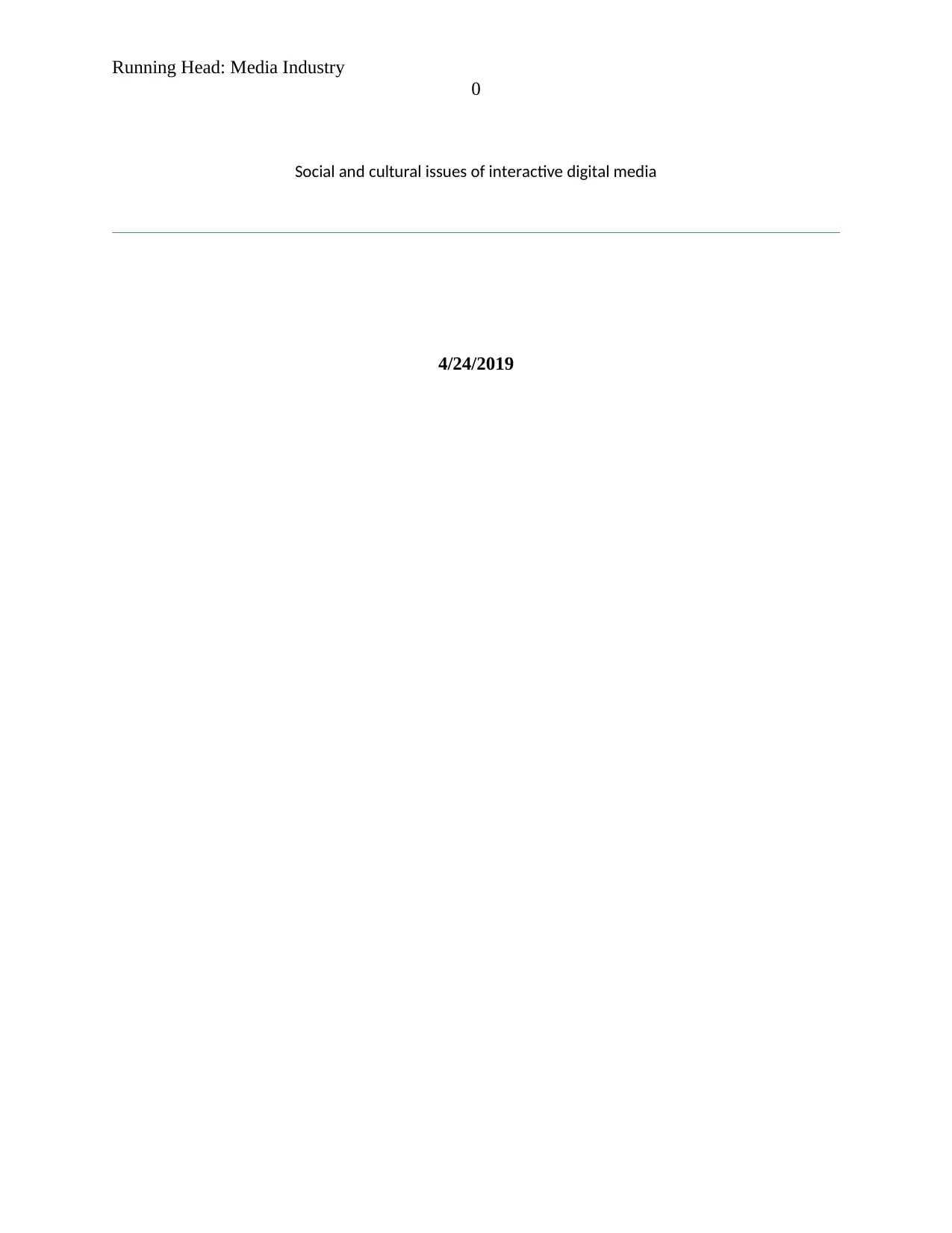
Running Head: Media Industry
0
Social and cultural issues of interactive digital media
4/24/2019
0
Social and cultural issues of interactive digital media
4/24/2019
Paraphrase This Document
Need a fresh take? Get an instant paraphrase of this document with our AI Paraphraser
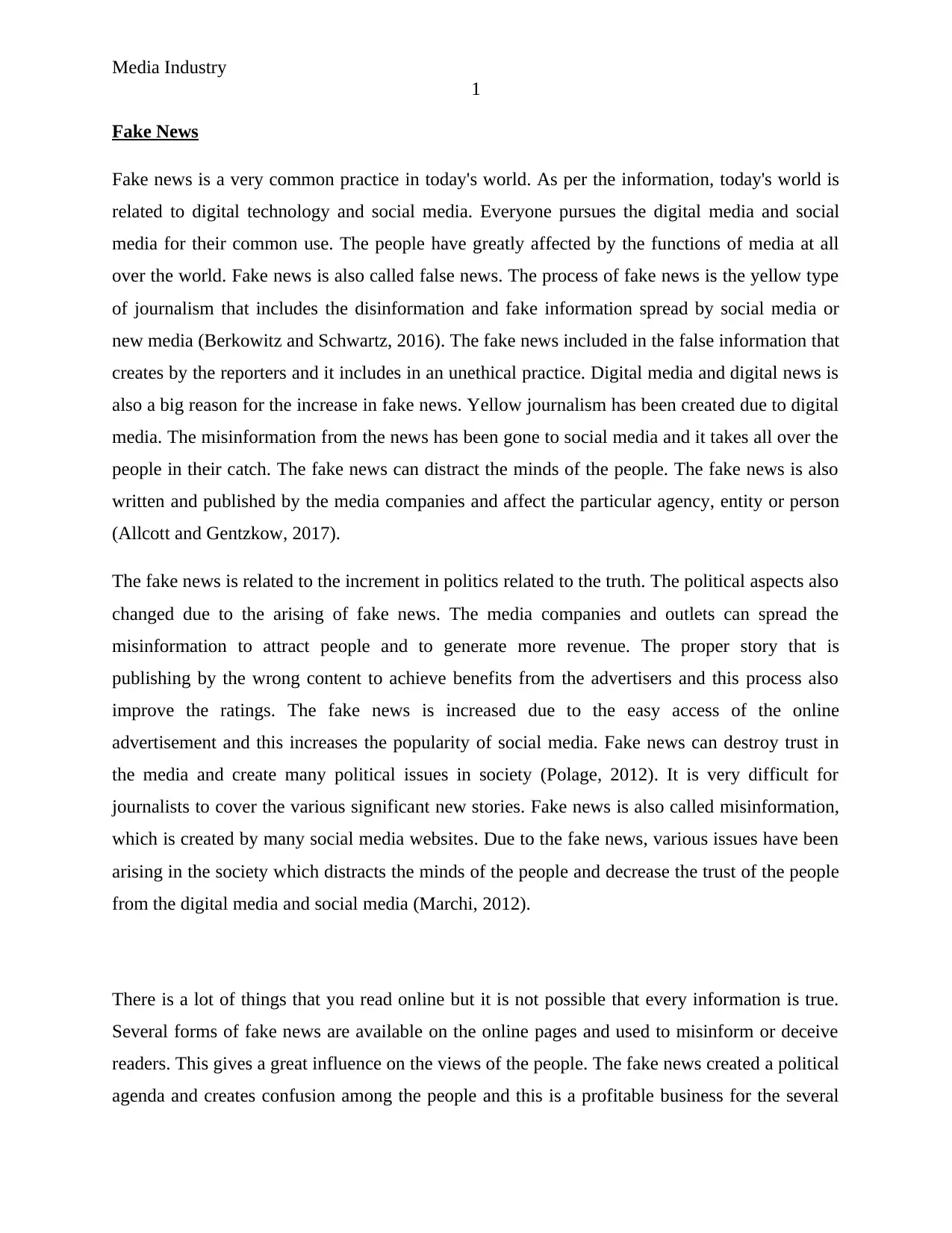
Media Industry
1
Fake News
Fake news is a very common practice in today's world. As per the information, today's world is
related to digital technology and social media. Everyone pursues the digital media and social
media for their common use. The people have greatly affected by the functions of media at all
over the world. Fake news is also called false news. The process of fake news is the yellow type
of journalism that includes the disinformation and fake information spread by social media or
new media (Berkowitz and Schwartz, 2016). The fake news included in the false information that
creates by the reporters and it includes in an unethical practice. Digital media and digital news is
also a big reason for the increase in fake news. Yellow journalism has been created due to digital
media. The misinformation from the news has been gone to social media and it takes all over the
people in their catch. The fake news can distract the minds of the people. The fake news is also
written and published by the media companies and affect the particular agency, entity or person
(Allcott and Gentzkow, 2017).
The fake news is related to the increment in politics related to the truth. The political aspects also
changed due to the arising of fake news. The media companies and outlets can spread the
misinformation to attract people and to generate more revenue. The proper story that is
publishing by the wrong content to achieve benefits from the advertisers and this process also
improve the ratings. The fake news is increased due to the easy access of the online
advertisement and this increases the popularity of social media. Fake news can destroy trust in
the media and create many political issues in society (Polage, 2012). It is very difficult for
journalists to cover the various significant new stories. Fake news is also called misinformation,
which is created by many social media websites. Due to the fake news, various issues have been
arising in the society which distracts the minds of the people and decrease the trust of the people
from the digital media and social media (Marchi, 2012).
There is a lot of things that you read online but it is not possible that every information is true.
Several forms of fake news are available on the online pages and used to misinform or deceive
readers. This gives a great influence on the views of the people. The fake news created a political
agenda and creates confusion among the people and this is a profitable business for the several
1
Fake News
Fake news is a very common practice in today's world. As per the information, today's world is
related to digital technology and social media. Everyone pursues the digital media and social
media for their common use. The people have greatly affected by the functions of media at all
over the world. Fake news is also called false news. The process of fake news is the yellow type
of journalism that includes the disinformation and fake information spread by social media or
new media (Berkowitz and Schwartz, 2016). The fake news included in the false information that
creates by the reporters and it includes in an unethical practice. Digital media and digital news is
also a big reason for the increase in fake news. Yellow journalism has been created due to digital
media. The misinformation from the news has been gone to social media and it takes all over the
people in their catch. The fake news can distract the minds of the people. The fake news is also
written and published by the media companies and affect the particular agency, entity or person
(Allcott and Gentzkow, 2017).
The fake news is related to the increment in politics related to the truth. The political aspects also
changed due to the arising of fake news. The media companies and outlets can spread the
misinformation to attract people and to generate more revenue. The proper story that is
publishing by the wrong content to achieve benefits from the advertisers and this process also
improve the ratings. The fake news is increased due to the easy access of the online
advertisement and this increases the popularity of social media. Fake news can destroy trust in
the media and create many political issues in society (Polage, 2012). It is very difficult for
journalists to cover the various significant new stories. Fake news is also called misinformation,
which is created by many social media websites. Due to the fake news, various issues have been
arising in the society which distracts the minds of the people and decrease the trust of the people
from the digital media and social media (Marchi, 2012).
There is a lot of things that you read online but it is not possible that every information is true.
Several forms of fake news are available on the online pages and used to misinform or deceive
readers. This gives a great influence on the views of the people. The fake news created a political
agenda and creates confusion among the people and this is a profitable business for the several
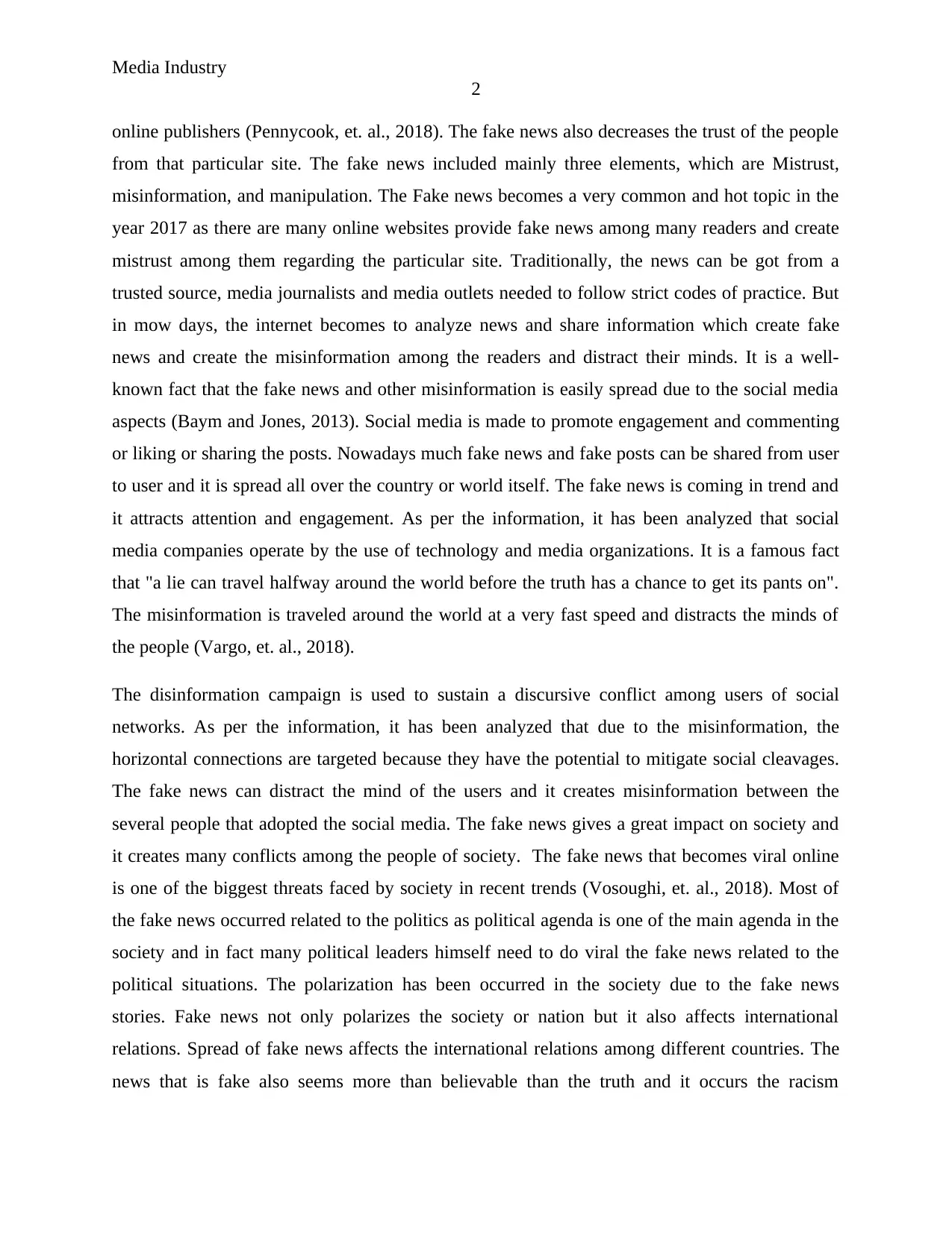
Media Industry
2
online publishers (Pennycook, et. al., 2018). The fake news also decreases the trust of the people
from that particular site. The fake news included mainly three elements, which are Mistrust,
misinformation, and manipulation. The Fake news becomes a very common and hot topic in the
year 2017 as there are many online websites provide fake news among many readers and create
mistrust among them regarding the particular site. Traditionally, the news can be got from a
trusted source, media journalists and media outlets needed to follow strict codes of practice. But
in mow days, the internet becomes to analyze news and share information which create fake
news and create the misinformation among the readers and distract their minds. It is a well-
known fact that the fake news and other misinformation is easily spread due to the social media
aspects (Baym and Jones, 2013). Social media is made to promote engagement and commenting
or liking or sharing the posts. Nowadays much fake news and fake posts can be shared from user
to user and it is spread all over the country or world itself. The fake news is coming in trend and
it attracts attention and engagement. As per the information, it has been analyzed that social
media companies operate by the use of technology and media organizations. It is a famous fact
that "a lie can travel halfway around the world before the truth has a chance to get its pants on".
The misinformation is traveled around the world at a very fast speed and distracts the minds of
the people (Vargo, et. al., 2018).
The disinformation campaign is used to sustain a discursive conflict among users of social
networks. As per the information, it has been analyzed that due to the misinformation, the
horizontal connections are targeted because they have the potential to mitigate social cleavages.
The fake news can distract the mind of the users and it creates misinformation between the
several people that adopted the social media. The fake news gives a great impact on society and
it creates many conflicts among the people of society. The fake news that becomes viral online
is one of the biggest threats faced by society in recent trends (Vosoughi, et. al., 2018). Most of
the fake news occurred related to the politics as political agenda is one of the main agenda in the
society and in fact many political leaders himself need to do viral the fake news related to the
political situations. The polarization has been occurred in the society due to the fake news
stories. Fake news not only polarizes the society or nation but it also affects international
relations. Spread of fake news affects the international relations among different countries. The
news that is fake also seems more than believable than the truth and it occurs the racism
2
online publishers (Pennycook, et. al., 2018). The fake news also decreases the trust of the people
from that particular site. The fake news included mainly three elements, which are Mistrust,
misinformation, and manipulation. The Fake news becomes a very common and hot topic in the
year 2017 as there are many online websites provide fake news among many readers and create
mistrust among them regarding the particular site. Traditionally, the news can be got from a
trusted source, media journalists and media outlets needed to follow strict codes of practice. But
in mow days, the internet becomes to analyze news and share information which create fake
news and create the misinformation among the readers and distract their minds. It is a well-
known fact that the fake news and other misinformation is easily spread due to the social media
aspects (Baym and Jones, 2013). Social media is made to promote engagement and commenting
or liking or sharing the posts. Nowadays much fake news and fake posts can be shared from user
to user and it is spread all over the country or world itself. The fake news is coming in trend and
it attracts attention and engagement. As per the information, it has been analyzed that social
media companies operate by the use of technology and media organizations. It is a famous fact
that "a lie can travel halfway around the world before the truth has a chance to get its pants on".
The misinformation is traveled around the world at a very fast speed and distracts the minds of
the people (Vargo, et. al., 2018).
The disinformation campaign is used to sustain a discursive conflict among users of social
networks. As per the information, it has been analyzed that due to the misinformation, the
horizontal connections are targeted because they have the potential to mitigate social cleavages.
The fake news can distract the mind of the users and it creates misinformation between the
several people that adopted the social media. The fake news gives a great impact on society and
it creates many conflicts among the people of society. The fake news that becomes viral online
is one of the biggest threats faced by society in recent trends (Vosoughi, et. al., 2018). Most of
the fake news occurred related to the politics as political agenda is one of the main agenda in the
society and in fact many political leaders himself need to do viral the fake news related to the
political situations. The polarization has been occurred in the society due to the fake news
stories. Fake news not only polarizes the society or nation but it also affects international
relations. Spread of fake news affects the international relations among different countries. The
news that is fake also seems more than believable than the truth and it occurs the racism
⊘ This is a preview!⊘
Do you want full access?
Subscribe today to unlock all pages.

Trusted by 1+ million students worldwide
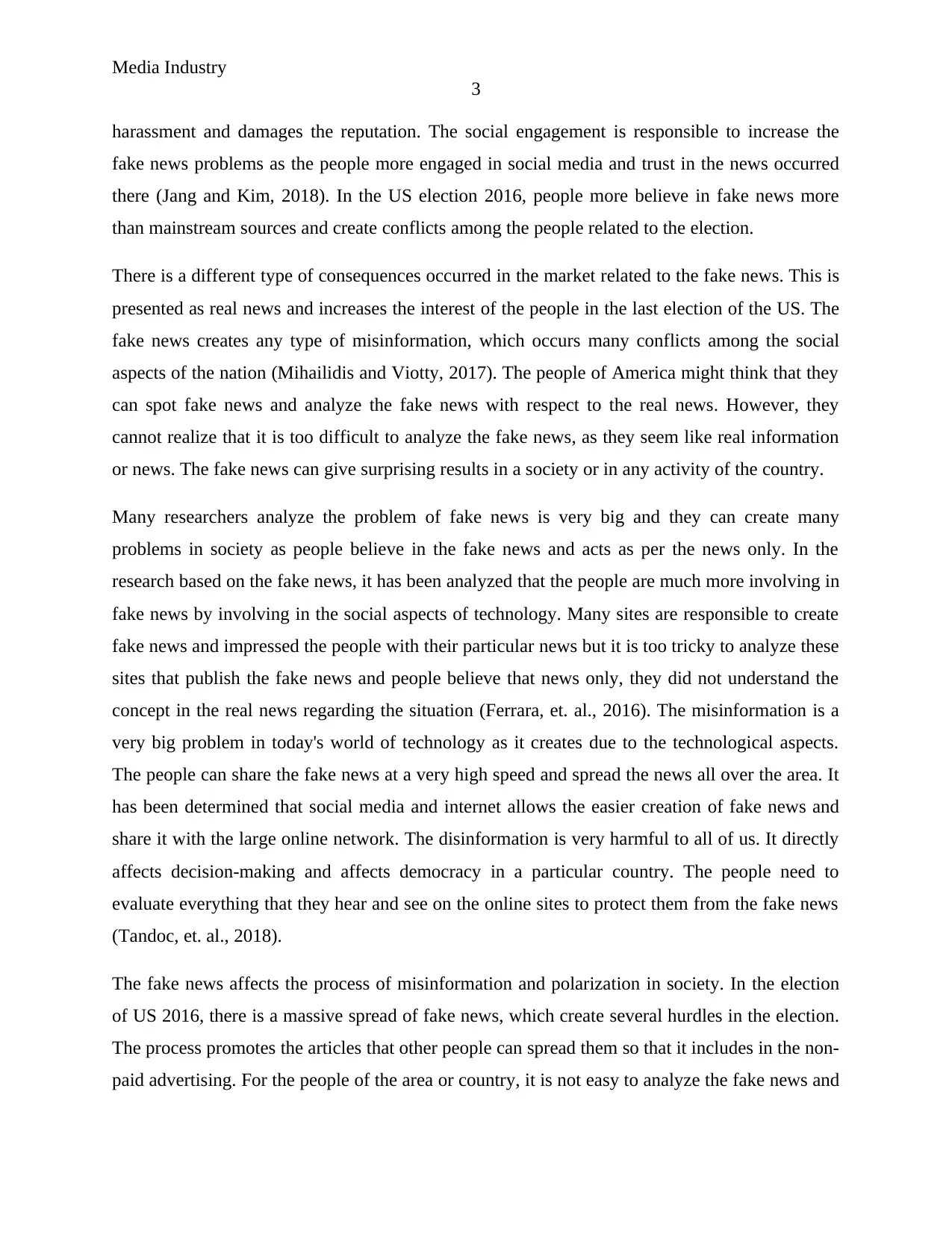
Media Industry
3
harassment and damages the reputation. The social engagement is responsible to increase the
fake news problems as the people more engaged in social media and trust in the news occurred
there (Jang and Kim, 2018). In the US election 2016, people more believe in fake news more
than mainstream sources and create conflicts among the people related to the election.
There is a different type of consequences occurred in the market related to the fake news. This is
presented as real news and increases the interest of the people in the last election of the US. The
fake news creates any type of misinformation, which occurs many conflicts among the social
aspects of the nation (Mihailidis and Viotty, 2017). The people of America might think that they
can spot fake news and analyze the fake news with respect to the real news. However, they
cannot realize that it is too difficult to analyze the fake news, as they seem like real information
or news. The fake news can give surprising results in a society or in any activity of the country.
Many researchers analyze the problem of fake news is very big and they can create many
problems in society as people believe in the fake news and acts as per the news only. In the
research based on the fake news, it has been analyzed that the people are much more involving in
fake news by involving in the social aspects of technology. Many sites are responsible to create
fake news and impressed the people with their particular news but it is too tricky to analyze these
sites that publish the fake news and people believe that news only, they did not understand the
concept in the real news regarding the situation (Ferrara, et. al., 2016). The misinformation is a
very big problem in today's world of technology as it creates due to the technological aspects.
The people can share the fake news at a very high speed and spread the news all over the area. It
has been determined that social media and internet allows the easier creation of fake news and
share it with the large online network. The disinformation is very harmful to all of us. It directly
affects decision-making and affects democracy in a particular country. The people need to
evaluate everything that they hear and see on the online sites to protect them from the fake news
(Tandoc, et. al., 2018).
The fake news affects the process of misinformation and polarization in society. In the election
of US 2016, there is a massive spread of fake news, which create several hurdles in the election.
The process promotes the articles that other people can spread them so that it includes in the non-
paid advertising. For the people of the area or country, it is not easy to analyze the fake news and
3
harassment and damages the reputation. The social engagement is responsible to increase the
fake news problems as the people more engaged in social media and trust in the news occurred
there (Jang and Kim, 2018). In the US election 2016, people more believe in fake news more
than mainstream sources and create conflicts among the people related to the election.
There is a different type of consequences occurred in the market related to the fake news. This is
presented as real news and increases the interest of the people in the last election of the US. The
fake news creates any type of misinformation, which occurs many conflicts among the social
aspects of the nation (Mihailidis and Viotty, 2017). The people of America might think that they
can spot fake news and analyze the fake news with respect to the real news. However, they
cannot realize that it is too difficult to analyze the fake news, as they seem like real information
or news. The fake news can give surprising results in a society or in any activity of the country.
Many researchers analyze the problem of fake news is very big and they can create many
problems in society as people believe in the fake news and acts as per the news only. In the
research based on the fake news, it has been analyzed that the people are much more involving in
fake news by involving in the social aspects of technology. Many sites are responsible to create
fake news and impressed the people with their particular news but it is too tricky to analyze these
sites that publish the fake news and people believe that news only, they did not understand the
concept in the real news regarding the situation (Ferrara, et. al., 2016). The misinformation is a
very big problem in today's world of technology as it creates due to the technological aspects.
The people can share the fake news at a very high speed and spread the news all over the area. It
has been determined that social media and internet allows the easier creation of fake news and
share it with the large online network. The disinformation is very harmful to all of us. It directly
affects decision-making and affects democracy in a particular country. The people need to
evaluate everything that they hear and see on the online sites to protect them from the fake news
(Tandoc, et. al., 2018).
The fake news affects the process of misinformation and polarization in society. In the election
of US 2016, there is a massive spread of fake news, which create several hurdles in the election.
The process promotes the articles that other people can spread them so that it includes in the non-
paid advertising. For the people of the area or country, it is not easy to analyze the fake news and
Paraphrase This Document
Need a fresh take? Get an instant paraphrase of this document with our AI Paraphraser
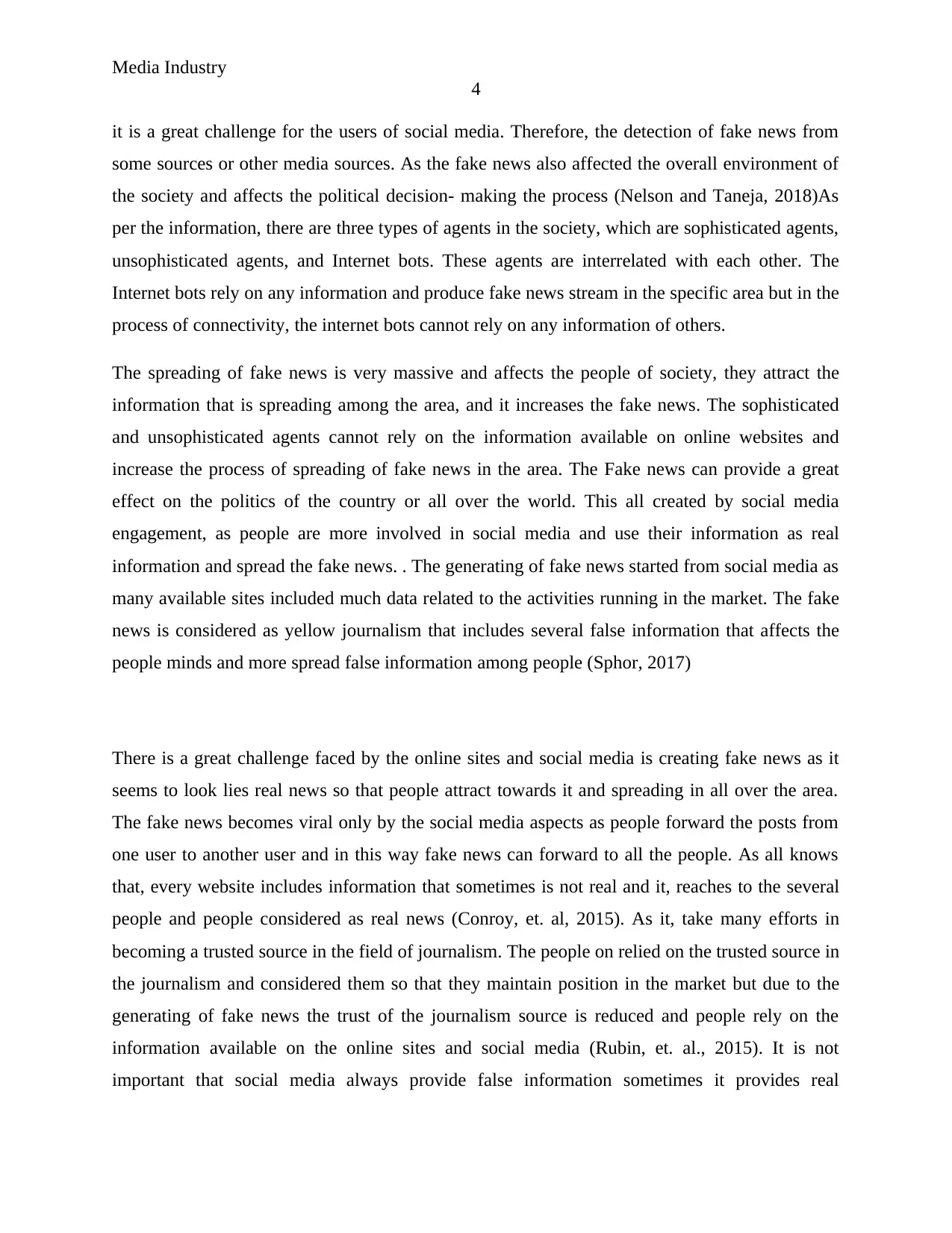
Media Industry
4
it is a great challenge for the users of social media. Therefore, the detection of fake news from
some sources or other media sources. As the fake news also affected the overall environment of
the society and affects the political decision- making the process (Nelson and Taneja, 2018)As
per the information, there are three types of agents in the society, which are sophisticated agents,
unsophisticated agents, and Internet bots. These agents are interrelated with each other. The
Internet bots rely on any information and produce fake news stream in the specific area but in the
process of connectivity, the internet bots cannot rely on any information of others.
The spreading of fake news is very massive and affects the people of society, they attract the
information that is spreading among the area, and it increases the fake news. The sophisticated
and unsophisticated agents cannot rely on the information available on online websites and
increase the process of spreading of fake news in the area. The Fake news can provide a great
effect on the politics of the country or all over the world. This all created by social media
engagement, as people are more involved in social media and use their information as real
information and spread the fake news. . The generating of fake news started from social media as
many available sites included much data related to the activities running in the market. The fake
news is considered as yellow journalism that includes several false information that affects the
people minds and more spread false information among people (Sphor, 2017)
There is a great challenge faced by the online sites and social media is creating fake news as it
seems to look lies real news so that people attract towards it and spreading in all over the area.
The fake news becomes viral only by the social media aspects as people forward the posts from
one user to another user and in this way fake news can forward to all the people. As all knows
that, every website includes information that sometimes is not real and it, reaches to the several
people and people considered as real news (Conroy, et. al, 2015). As it, take many efforts in
becoming a trusted source in the field of journalism. The people on relied on the trusted source in
the journalism and considered them so that they maintain position in the market but due to the
generating of fake news the trust of the journalism source is reduced and people rely on the
information available on the online sites and social media (Rubin, et. al., 2015). It is not
important that social media always provide false information sometimes it provides real
4
it is a great challenge for the users of social media. Therefore, the detection of fake news from
some sources or other media sources. As the fake news also affected the overall environment of
the society and affects the political decision- making the process (Nelson and Taneja, 2018)As
per the information, there are three types of agents in the society, which are sophisticated agents,
unsophisticated agents, and Internet bots. These agents are interrelated with each other. The
Internet bots rely on any information and produce fake news stream in the specific area but in the
process of connectivity, the internet bots cannot rely on any information of others.
The spreading of fake news is very massive and affects the people of society, they attract the
information that is spreading among the area, and it increases the fake news. The sophisticated
and unsophisticated agents cannot rely on the information available on online websites and
increase the process of spreading of fake news in the area. The Fake news can provide a great
effect on the politics of the country or all over the world. This all created by social media
engagement, as people are more involved in social media and use their information as real
information and spread the fake news. . The generating of fake news started from social media as
many available sites included much data related to the activities running in the market. The fake
news is considered as yellow journalism that includes several false information that affects the
people minds and more spread false information among people (Sphor, 2017)
There is a great challenge faced by the online sites and social media is creating fake news as it
seems to look lies real news so that people attract towards it and spreading in all over the area.
The fake news becomes viral only by the social media aspects as people forward the posts from
one user to another user and in this way fake news can forward to all the people. As all knows
that, every website includes information that sometimes is not real and it, reaches to the several
people and people considered as real news (Conroy, et. al, 2015). As it, take many efforts in
becoming a trusted source in the field of journalism. The people on relied on the trusted source in
the journalism and considered them so that they maintain position in the market but due to the
generating of fake news the trust of the journalism source is reduced and people rely on the
information available on the online sites and social media (Rubin, et. al., 2015). It is not
important that social media always provide false information sometimes it provides real
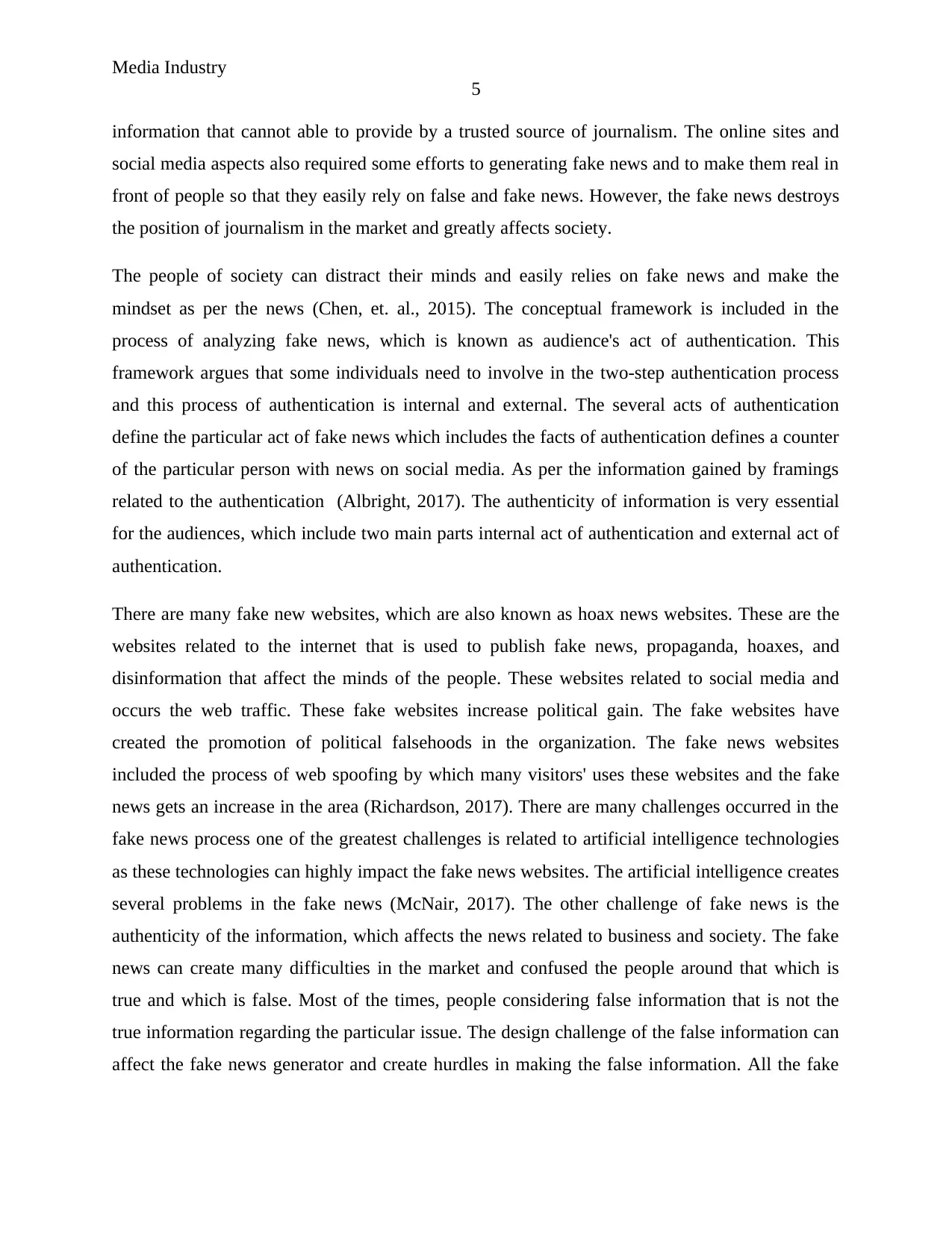
Media Industry
5
information that cannot able to provide by a trusted source of journalism. The online sites and
social media aspects also required some efforts to generating fake news and to make them real in
front of people so that they easily rely on false and fake news. However, the fake news destroys
the position of journalism in the market and greatly affects society.
The people of society can distract their minds and easily relies on fake news and make the
mindset as per the news (Chen, et. al., 2015). The conceptual framework is included in the
process of analyzing fake news, which is known as audience's act of authentication. This
framework argues that some individuals need to involve in the two-step authentication process
and this process of authentication is internal and external. The several acts of authentication
define the particular act of fake news which includes the facts of authentication defines a counter
of the particular person with news on social media. As per the information gained by framings
related to the authentication (Albright, 2017). The authenticity of information is very essential
for the audiences, which include two main parts internal act of authentication and external act of
authentication.
There are many fake new websites, which are also known as hoax news websites. These are the
websites related to the internet that is used to publish fake news, propaganda, hoaxes, and
disinformation that affect the minds of the people. These websites related to social media and
occurs the web traffic. These fake websites increase political gain. The fake websites have
created the promotion of political falsehoods in the organization. The fake news websites
included the process of web spoofing by which many visitors' uses these websites and the fake
news gets an increase in the area (Richardson, 2017). There are many challenges occurred in the
fake news process one of the greatest challenges is related to artificial intelligence technologies
as these technologies can highly impact the fake news websites. The artificial intelligence creates
several problems in the fake news (McNair, 2017). The other challenge of fake news is the
authenticity of the information, which affects the news related to business and society. The fake
news can create many difficulties in the market and confused the people around that which is
true and which is false. Most of the times, people considering false information that is not the
true information regarding the particular issue. The design challenge of the false information can
affect the fake news generator and create hurdles in making the false information. All the fake
5
information that cannot able to provide by a trusted source of journalism. The online sites and
social media aspects also required some efforts to generating fake news and to make them real in
front of people so that they easily rely on false and fake news. However, the fake news destroys
the position of journalism in the market and greatly affects society.
The people of society can distract their minds and easily relies on fake news and make the
mindset as per the news (Chen, et. al., 2015). The conceptual framework is included in the
process of analyzing fake news, which is known as audience's act of authentication. This
framework argues that some individuals need to involve in the two-step authentication process
and this process of authentication is internal and external. The several acts of authentication
define the particular act of fake news which includes the facts of authentication defines a counter
of the particular person with news on social media. As per the information gained by framings
related to the authentication (Albright, 2017). The authenticity of information is very essential
for the audiences, which include two main parts internal act of authentication and external act of
authentication.
There are many fake new websites, which are also known as hoax news websites. These are the
websites related to the internet that is used to publish fake news, propaganda, hoaxes, and
disinformation that affect the minds of the people. These websites related to social media and
occurs the web traffic. These fake websites increase political gain. The fake websites have
created the promotion of political falsehoods in the organization. The fake news websites
included the process of web spoofing by which many visitors' uses these websites and the fake
news gets an increase in the area (Richardson, 2017). There are many challenges occurred in the
fake news process one of the greatest challenges is related to artificial intelligence technologies
as these technologies can highly impact the fake news websites. The artificial intelligence creates
several problems in the fake news (McNair, 2017). The other challenge of fake news is the
authenticity of the information, which affects the news related to business and society. The fake
news can create many difficulties in the market and confused the people around that which is
true and which is false. Most of the times, people considering false information that is not the
true information regarding the particular issue. The design challenge of the false information can
affect the fake news generator and create hurdles in making the false information. All the fake
⊘ This is a preview!⊘
Do you want full access?
Subscribe today to unlock all pages.

Trusted by 1+ million students worldwide
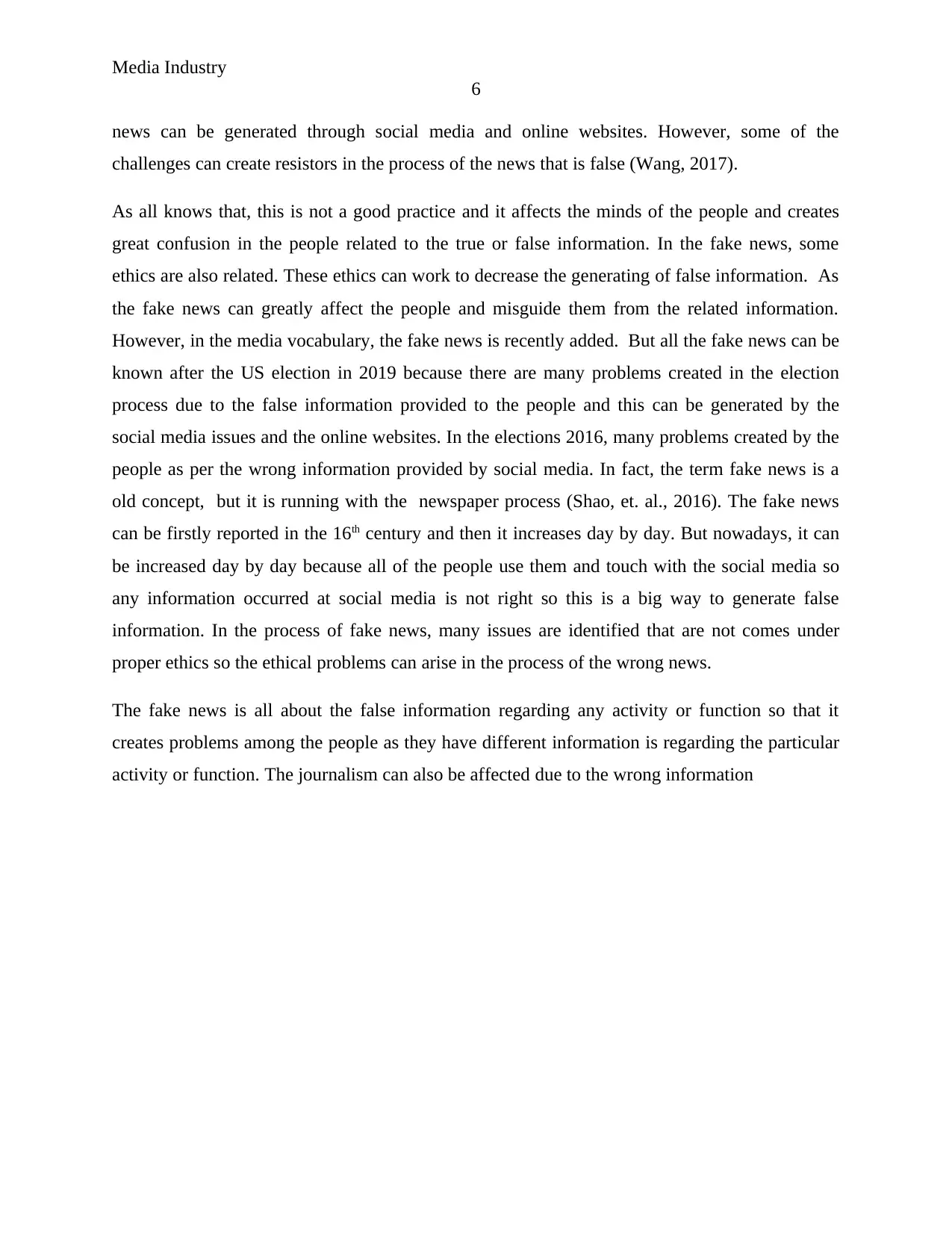
Media Industry
6
news can be generated through social media and online websites. However, some of the
challenges can create resistors in the process of the news that is false (Wang, 2017).
As all knows that, this is not a good practice and it affects the minds of the people and creates
great confusion in the people related to the true or false information. In the fake news, some
ethics are also related. These ethics can work to decrease the generating of false information. As
the fake news can greatly affect the people and misguide them from the related information.
However, in the media vocabulary, the fake news is recently added. But all the fake news can be
known after the US election in 2019 because there are many problems created in the election
process due to the false information provided to the people and this can be generated by the
social media issues and the online websites. In the elections 2016, many problems created by the
people as per the wrong information provided by social media. In fact, the term fake news is a
old concept, but it is running with the newspaper process (Shao, et. al., 2016). The fake news
can be firstly reported in the 16th century and then it increases day by day. But nowadays, it can
be increased day by day because all of the people use them and touch with the social media so
any information occurred at social media is not right so this is a big way to generate false
information. In the process of fake news, many issues are identified that are not comes under
proper ethics so the ethical problems can arise in the process of the wrong news.
The fake news is all about the false information regarding any activity or function so that it
creates problems among the people as they have different information is regarding the particular
activity or function. The journalism can also be affected due to the wrong information
6
news can be generated through social media and online websites. However, some of the
challenges can create resistors in the process of the news that is false (Wang, 2017).
As all knows that, this is not a good practice and it affects the minds of the people and creates
great confusion in the people related to the true or false information. In the fake news, some
ethics are also related. These ethics can work to decrease the generating of false information. As
the fake news can greatly affect the people and misguide them from the related information.
However, in the media vocabulary, the fake news is recently added. But all the fake news can be
known after the US election in 2019 because there are many problems created in the election
process due to the false information provided to the people and this can be generated by the
social media issues and the online websites. In the elections 2016, many problems created by the
people as per the wrong information provided by social media. In fact, the term fake news is a
old concept, but it is running with the newspaper process (Shao, et. al., 2016). The fake news
can be firstly reported in the 16th century and then it increases day by day. But nowadays, it can
be increased day by day because all of the people use them and touch with the social media so
any information occurred at social media is not right so this is a big way to generate false
information. In the process of fake news, many issues are identified that are not comes under
proper ethics so the ethical problems can arise in the process of the wrong news.
The fake news is all about the false information regarding any activity or function so that it
creates problems among the people as they have different information is regarding the particular
activity or function. The journalism can also be affected due to the wrong information
Paraphrase This Document
Need a fresh take? Get an instant paraphrase of this document with our AI Paraphraser
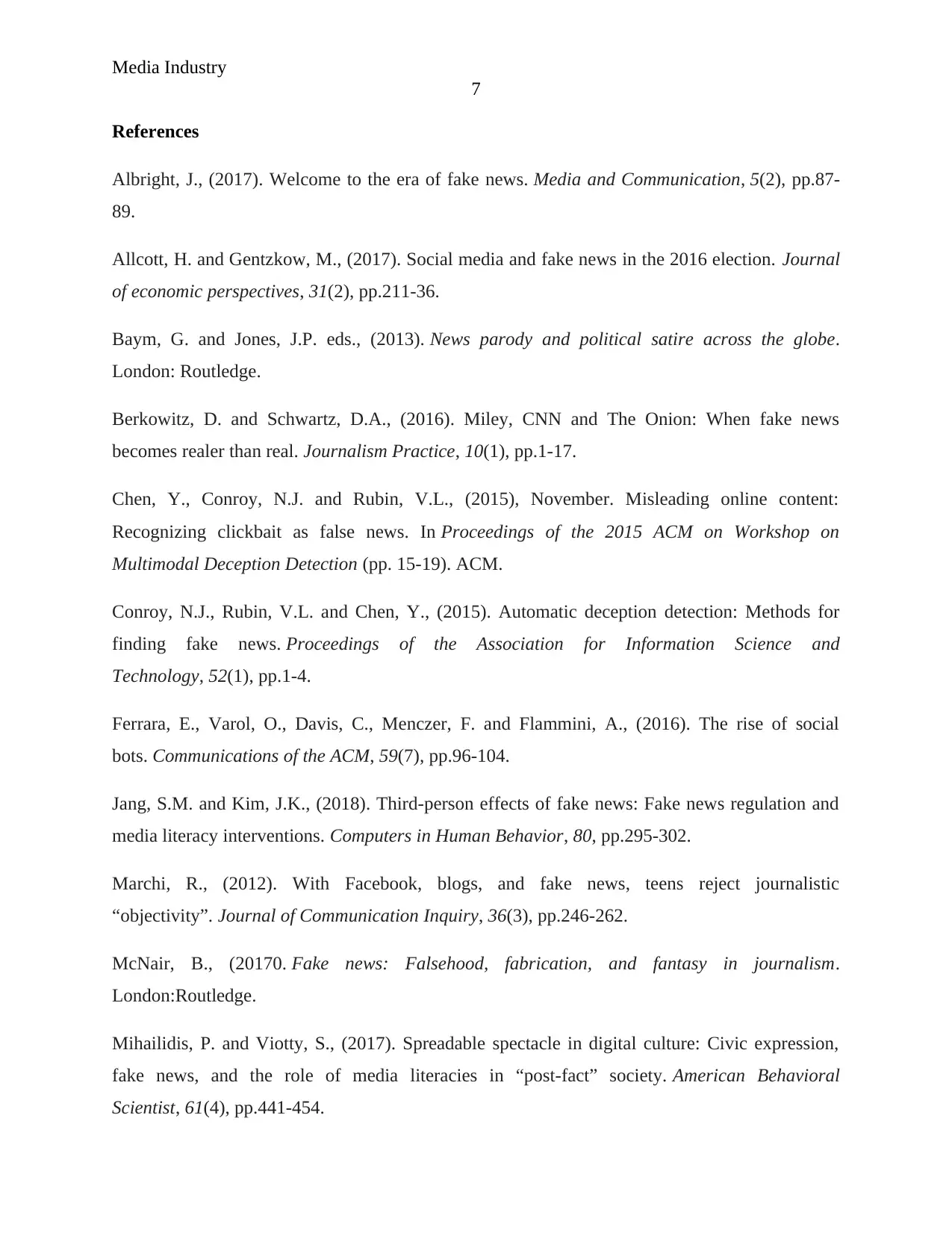
Media Industry
7
References
Albright, J., (2017). Welcome to the era of fake news. Media and Communication, 5(2), pp.87-
89.
Allcott, H. and Gentzkow, M., (2017). Social media and fake news in the 2016 election. Journal
of economic perspectives, 31(2), pp.211-36.
Baym, G. and Jones, J.P. eds., (2013). News parody and political satire across the globe.
London: Routledge.
Berkowitz, D. and Schwartz, D.A., (2016). Miley, CNN and The Onion: When fake news
becomes realer than real. Journalism Practice, 10(1), pp.1-17.
Chen, Y., Conroy, N.J. and Rubin, V.L., (2015), November. Misleading online content:
Recognizing clickbait as false news. In Proceedings of the 2015 ACM on Workshop on
Multimodal Deception Detection (pp. 15-19). ACM.
Conroy, N.J., Rubin, V.L. and Chen, Y., (2015). Automatic deception detection: Methods for
finding fake news. Proceedings of the Association for Information Science and
Technology, 52(1), pp.1-4.
Ferrara, E., Varol, O., Davis, C., Menczer, F. and Flammini, A., (2016). The rise of social
bots. Communications of the ACM, 59(7), pp.96-104.
Jang, S.M. and Kim, J.K., (2018). Third-person effects of fake news: Fake news regulation and
media literacy interventions. Computers in Human Behavior, 80, pp.295-302.
Marchi, R., (2012). With Facebook, blogs, and fake news, teens reject journalistic
“objectivity”. Journal of Communication Inquiry, 36(3), pp.246-262.
McNair, B., (20170. Fake news: Falsehood, fabrication, and fantasy in journalism.
London:Routledge.
Mihailidis, P. and Viotty, S., (2017). Spreadable spectacle in digital culture: Civic expression,
fake news, and the role of media literacies in “post-fact” society. American Behavioral
Scientist, 61(4), pp.441-454.
7
References
Albright, J., (2017). Welcome to the era of fake news. Media and Communication, 5(2), pp.87-
89.
Allcott, H. and Gentzkow, M., (2017). Social media and fake news in the 2016 election. Journal
of economic perspectives, 31(2), pp.211-36.
Baym, G. and Jones, J.P. eds., (2013). News parody and political satire across the globe.
London: Routledge.
Berkowitz, D. and Schwartz, D.A., (2016). Miley, CNN and The Onion: When fake news
becomes realer than real. Journalism Practice, 10(1), pp.1-17.
Chen, Y., Conroy, N.J. and Rubin, V.L., (2015), November. Misleading online content:
Recognizing clickbait as false news. In Proceedings of the 2015 ACM on Workshop on
Multimodal Deception Detection (pp. 15-19). ACM.
Conroy, N.J., Rubin, V.L. and Chen, Y., (2015). Automatic deception detection: Methods for
finding fake news. Proceedings of the Association for Information Science and
Technology, 52(1), pp.1-4.
Ferrara, E., Varol, O., Davis, C., Menczer, F. and Flammini, A., (2016). The rise of social
bots. Communications of the ACM, 59(7), pp.96-104.
Jang, S.M. and Kim, J.K., (2018). Third-person effects of fake news: Fake news regulation and
media literacy interventions. Computers in Human Behavior, 80, pp.295-302.
Marchi, R., (2012). With Facebook, blogs, and fake news, teens reject journalistic
“objectivity”. Journal of Communication Inquiry, 36(3), pp.246-262.
McNair, B., (20170. Fake news: Falsehood, fabrication, and fantasy in journalism.
London:Routledge.
Mihailidis, P. and Viotty, S., (2017). Spreadable spectacle in digital culture: Civic expression,
fake news, and the role of media literacies in “post-fact” society. American Behavioral
Scientist, 61(4), pp.441-454.
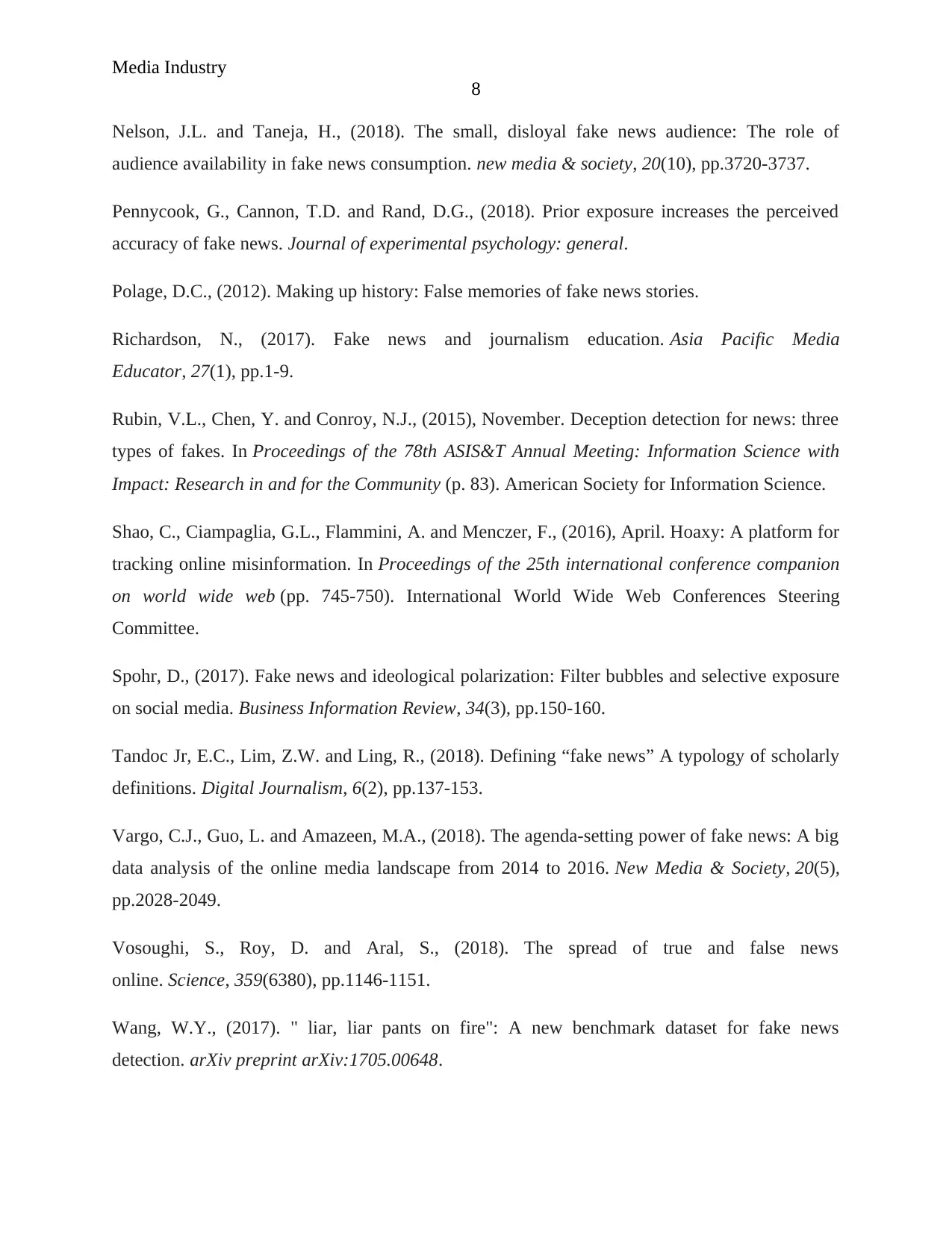
Media Industry
8
Nelson, J.L. and Taneja, H., (2018). The small, disloyal fake news audience: The role of
audience availability in fake news consumption. new media & society, 20(10), pp.3720-3737.
Pennycook, G., Cannon, T.D. and Rand, D.G., (2018). Prior exposure increases the perceived
accuracy of fake news. Journal of experimental psychology: general.
Polage, D.C., (2012). Making up history: False memories of fake news stories.
Richardson, N., (2017). Fake news and journalism education. Asia Pacific Media
Educator, 27(1), pp.1-9.
Rubin, V.L., Chen, Y. and Conroy, N.J., (2015), November. Deception detection for news: three
types of fakes. In Proceedings of the 78th ASIS&T Annual Meeting: Information Science with
Impact: Research in and for the Community (p. 83). American Society for Information Science.
Shao, C., Ciampaglia, G.L., Flammini, A. and Menczer, F., (2016), April. Hoaxy: A platform for
tracking online misinformation. In Proceedings of the 25th international conference companion
on world wide web (pp. 745-750). International World Wide Web Conferences Steering
Committee.
Spohr, D., (2017). Fake news and ideological polarization: Filter bubbles and selective exposure
on social media. Business Information Review, 34(3), pp.150-160.
Tandoc Jr, E.C., Lim, Z.W. and Ling, R., (2018). Defining “fake news” A typology of scholarly
definitions. Digital Journalism, 6(2), pp.137-153.
Vargo, C.J., Guo, L. and Amazeen, M.A., (2018). The agenda-setting power of fake news: A big
data analysis of the online media landscape from 2014 to 2016. New Media & Society, 20(5),
pp.2028-2049.
Vosoughi, S., Roy, D. and Aral, S., (2018). The spread of true and false news
online. Science, 359(6380), pp.1146-1151.
Wang, W.Y., (2017). " liar, liar pants on fire": A new benchmark dataset for fake news
detection. arXiv preprint arXiv:1705.00648.
8
Nelson, J.L. and Taneja, H., (2018). The small, disloyal fake news audience: The role of
audience availability in fake news consumption. new media & society, 20(10), pp.3720-3737.
Pennycook, G., Cannon, T.D. and Rand, D.G., (2018). Prior exposure increases the perceived
accuracy of fake news. Journal of experimental psychology: general.
Polage, D.C., (2012). Making up history: False memories of fake news stories.
Richardson, N., (2017). Fake news and journalism education. Asia Pacific Media
Educator, 27(1), pp.1-9.
Rubin, V.L., Chen, Y. and Conroy, N.J., (2015), November. Deception detection for news: three
types of fakes. In Proceedings of the 78th ASIS&T Annual Meeting: Information Science with
Impact: Research in and for the Community (p. 83). American Society for Information Science.
Shao, C., Ciampaglia, G.L., Flammini, A. and Menczer, F., (2016), April. Hoaxy: A platform for
tracking online misinformation. In Proceedings of the 25th international conference companion
on world wide web (pp. 745-750). International World Wide Web Conferences Steering
Committee.
Spohr, D., (2017). Fake news and ideological polarization: Filter bubbles and selective exposure
on social media. Business Information Review, 34(3), pp.150-160.
Tandoc Jr, E.C., Lim, Z.W. and Ling, R., (2018). Defining “fake news” A typology of scholarly
definitions. Digital Journalism, 6(2), pp.137-153.
Vargo, C.J., Guo, L. and Amazeen, M.A., (2018). The agenda-setting power of fake news: A big
data analysis of the online media landscape from 2014 to 2016. New Media & Society, 20(5),
pp.2028-2049.
Vosoughi, S., Roy, D. and Aral, S., (2018). The spread of true and false news
online. Science, 359(6380), pp.1146-1151.
Wang, W.Y., (2017). " liar, liar pants on fire": A new benchmark dataset for fake news
detection. arXiv preprint arXiv:1705.00648.
⊘ This is a preview!⊘
Do you want full access?
Subscribe today to unlock all pages.

Trusted by 1+ million students worldwide

Media Industry
9
9
1 out of 10
Related Documents
Your All-in-One AI-Powered Toolkit for Academic Success.
+13062052269
info@desklib.com
Available 24*7 on WhatsApp / Email
![[object Object]](/_next/static/media/star-bottom.7253800d.svg)
Unlock your academic potential
Copyright © 2020–2025 A2Z Services. All Rights Reserved. Developed and managed by ZUCOL.





